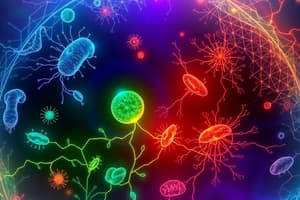Podcast
Questions and Answers
What are Toll-like receptors (TLRs) primarily responsible for in innate immunity?
What are Toll-like receptors (TLRs) primarily responsible for in innate immunity?
- Enclosing the infected area with tissue fibers
- Increasing blood flow to tissues
- Attaching to pathogenic microbes (correct)
- Producing toxins against viruses
Which of the following is NOT a characteristic of inflammation?
Which of the following is NOT a characteristic of inflammation?
- Rapid cell division (correct)
- Heat
- Swelling (edema)
- Redness
What is the role of neutrophils in the immune response?
What is the role of neutrophils in the immune response?
- Phagocytosis (correct)
- Killing parasitic worms
- Releasing histamine
- Producing antibodies
What does leukocytosis indicate?
What does leukocytosis indicate?
Which of the following components are recognized as pathogen-associated molecular patterns (PAMPs)?
Which of the following components are recognized as pathogen-associated molecular patterns (PAMPs)?
Which type of white blood cell is primarily involved in killing parasites?
Which type of white blood cell is primarily involved in killing parasites?
Which action does NOT occur during the inflammatory response?
Which action does NOT occur during the inflammatory response?
What indicates a decrease in white blood cell count?
What indicates a decrease in white blood cell count?
What is the primary effect of histamine on blood vessels?
What is the primary effect of histamine on blood vessels?
Which chemical specifically intensifies the effects of histamine and kinin?
Which chemical specifically intensifies the effects of histamine and kinin?
Which of the following chemicals is NOT released by damaged cells?
Which of the following chemicals is NOT released by damaged cells?
Which of the following describes the role of leukotrienes in inflammation?
Which of the following describes the role of leukotrienes in inflammation?
What role do cytokines play in the immune response initiated by macrophages?
What role do cytokines play in the immune response initiated by macrophages?
What event occurs immediately following tissue damage in the inflammatory process?
What event occurs immediately following tissue damage in the inflammatory process?
Which step follows the release of inflammatory chemicals in the process of inflammation?
Which step follows the release of inflammatory chemicals in the process of inflammation?
How does fever contribute to the body's defense against pathogens?
How does fever contribute to the body's defense against pathogens?
What is the outcome of a macrophage ingesting a gram-negative bacterium?
What is the outcome of a macrophage ingesting a gram-negative bacterium?
Which statement best describes the role of kinins in inflammation?
Which statement best describes the role of kinins in inflammation?
What is the outcome of the inflammatory process involving abscess formation?
What is the outcome of the inflammatory process involving abscess formation?
Where do the cytokines produced by macrophages travel to exert their effect?
Where do the cytokines produced by macrophages travel to exert their effect?
What is the primary function of the prostaglandins produced in response to cytokines?
What is the primary function of the prostaglandins produced in response to cytokines?
Which of the following processes is NOT associated with the body's fever response?
Which of the following processes is NOT associated with the body's fever response?
What triggers the macrophage to produce cytokines?
What triggers the macrophage to produce cytokines?
What is the initial action taken by a macrophage once it ingests a gram-negative bacterium?
What is the initial action taken by a macrophage once it ingests a gram-negative bacterium?
What is the first step in the process of inflammation as described?
What is the first step in the process of inflammation as described?
Which process directly follows the margination of phagocytes during inflammation?
Which process directly follows the margination of phagocytes during inflammation?
During a fever, what triggers the hypothalamus to reset to a higher temperature?
During a fever, what triggers the hypothalamus to reset to a higher temperature?
What physiological change occurs when the body temperature rises during a fever?
What physiological change occurs when the body temperature rises during a fever?
What phase follows the resolution of an infection, characterized by a drop in body temperature?
What phase follows the resolution of an infection, characterized by a drop in body temperature?
What role do endotoxins play in the inflammatory response?
What role do endotoxins play in the inflammatory response?
Which of the following describes the process of phagocytosis in inflammation?
Which of the following describes the process of phagocytosis in inflammation?
What occurs immediately after vasodilation in response to inflammation?
What occurs immediately after vasodilation in response to inflammation?
What best describes susceptibility in the context of immunity?
What best describes susceptibility in the context of immunity?
Which of the following is considered a first line of defense in the body?
Which of the following is considered a first line of defense in the body?
How do leukocidins contribute to microbial evasion of the immune system?
How do leukocidins contribute to microbial evasion of the immune system?
What is the primary role of the second line of defense in the immune system?
What is the primary role of the second line of defense in the immune system?
Which type of immunity is characterized by the body's ability to respond to specific pathogens?
Which type of immunity is characterized by the body's ability to respond to specific pathogens?
What mechanism allows pathogens like Mycobacterium tuberculosis to evade phagocytosis?
What mechanism allows pathogens like Mycobacterium tuberculosis to evade phagocytosis?
What role do antimicrobial chemicals play in innate immunity?
What role do antimicrobial chemicals play in innate immunity?
Which cell types are specifically involved in the adaptive immune response?
Which cell types are specifically involved in the adaptive immune response?
Flashcards
Innate Immunity
Innate Immunity
The body's first line of defense against pathogens, providing general protection against a broad range of threats.
Resistance
Resistance
The body's ability to ward off disease.
Susceptibility
Susceptibility
The lack of resistance, making someone vulnerable to disease.
First Line of Defense
First Line of Defense
Signup and view all the flashcards
Second Line of Defense
Second Line of Defense
Signup and view all the flashcards
Pathogen
Pathogen
Signup and view all the flashcards
Phagocytes
Phagocytes
Signup and view all the flashcards
Inflammation
Inflammation
Signup and view all the flashcards
Toll-like receptors (TLRs)
Toll-like receptors (TLRs)
Signup and view all the flashcards
Pattern-recognition receptors (PRRs)
Pattern-recognition receptors (PRRs)
Signup and view all the flashcards
Pathogen-associated molecular patterns (PAMPs)
Pathogen-associated molecular patterns (PAMPs)
Signup and view all the flashcards
What do TLRs and PRRs do?
What do TLRs and PRRs do?
Signup and view all the flashcards
Neutrophils
Neutrophils
Signup and view all the flashcards
Leukocytosis
Leukocytosis
Signup and view all the flashcards
Vasodilation
Vasodilation
Signup and view all the flashcards
Chemicals Released by Damaged Cells
Chemicals Released by Damaged Cells
Signup and view all the flashcards
Histamine's Role
Histamine's Role
Signup and view all the flashcards
Kinins' Function
Kinins' Function
Signup and view all the flashcards
Prostaglandins' Effect
Prostaglandins' Effect
Signup and view all the flashcards
Leukotrienes' Function
Leukotrienes' Function
Signup and view all the flashcards
What is Vasodilation?
What is Vasodilation?
Signup and view all the flashcards
What is Increased Permeability?
What is Increased Permeability?
Signup and view all the flashcards
Inflammation's Purpose
Inflammation's Purpose
Signup and view all the flashcards
Margination
Margination
Signup and view all the flashcards
Diapedesis
Diapedesis
Signup and view all the flashcards
Fever
Fever
Signup and view all the flashcards
Hypothalamus
Hypothalamus
Signup and view all the flashcards
Prostaglandins
Prostaglandins
Signup and view all the flashcards
Crisis
Crisis
Signup and view all the flashcards
Endotoxin
Endotoxin
Signup and view all the flashcards
Macrophage
Macrophage
Signup and view all the flashcards
Cytokines
Cytokines
Signup and view all the flashcards
How does endotoxin trigger fever?
How does endotoxin trigger fever?
Signup and view all the flashcards
What is the role of the hypothalamus in fever?
What is the role of the hypothalamus in fever?
Signup and view all the flashcards
How does fever fight infection?
How does fever fight infection?
Signup and view all the flashcards
What is the benefit of fever?
What is the benefit of fever?
Signup and view all the flashcards
Study Notes
Innate Immunity: Nonspecific Defenses of the Host
- Innate immunity is the body's first and second line of defense against pathogens
- Resistance is the body's ability to ward off disease
- Resistance factors include: skin, stomach acid, and antimicrobial chemicals
- Pathogenic microbes and host resistance determine disease contraction
- Immunity (resistance) is the body's ability to ward off diseases
- Innate immunity
- Adaptive immunity
Body Defenses Against Infection
- Pathogens are disease-causing agents
- The body has three lines of defense against infection
- Nonspecific defenses (first and second lines of defense) defend against many pathogens
- Specific defenses (adaptive immunity, third line of defense) target specific pathogens with lymphocytes
Overview of Body Defenses
- Innate Immunity (First Line of Defense):
- Intact skin
- Mucous membranes and their secretions
- Normal microbiota
- Innate Immunity (Second Line of Defense):
- Phagocytes (neutrophils, eosinophils, dendritic cells, and macrophages)
- Inflammation
- Fever
- Antimicrobial substances
- Adaptive Immunity (Third Line of Defense):
- Specialized lymphocytes (T cells and B cells)
- Antibodies
Microbial Evasion of Phagocytosis
- Pathogens can evade phagocytosis in several ways
- Examples include inhibiting adherence, killing phagocytes, lysing phagocytes, escaping the phagosome, preventing phagosome-lysosome fusion, and surviving in phagolysosomes
Recognition of Pathogens by Immune Cells
- Toll-like receptors (TLRs) and Pattern-recognition receptors (PRRs) are protein receptors on defensive host cells, such as neutrophils, macrophages, and dendritic cells
- TLRs and PRRs recognize pathogen-associated molecular patterns (PAMPs) on pathogens
TLRs and PAMPs
- TLRs recognize specific PAMPs (patterns) on pathogens
- Different TLRs recognize different PAMPs
- Recognition triggers an innate immune response
Differential White Cell Count
- Normal proportions of different white blood cells in a sample
- Includes percentages for neutrophils, basophils, eosinophils, monocytes, and lymphocytes
- Variations in counts can indicate infection or other issues
Inflammation
- A tissue response to a pathogen
- Characterized by redness, swelling, heat, and pain
- Major processes in inflammation:
- Vasodilation (blood vessel widening)
- Increased permeability of blood vessels
- Invasion of white blood cells into the affected area
- Formation of tissue fibers to prevent pathogen spread
Chemicals Released During Inflammation
- Histamine
- Kinins
- Prostaglandins
- Leukotrienes
The Process of Inflammation
- Tissue damage initiates a chain of events
- Chemicals like histamine, kinins, prostaglandins, leukotrienes, and cytokines are released
- This causes vasodilation and increased permeability
- Blood clots form, abscesses form, and phagocytes migrate to infected areas
Fever
- Abnormally high body temperature
- Hypothalamus (body's thermostat) is normally set at 37°C (98.6°F)
- Gram-negative endotoxins trigger phagocytes to release cytokines, leading to the hypothalamus releasing prostaglandins
- The hypothalamus increases body temperature
- Vasoconstriction conserves heat
- Increased metabolism
- Shivering also raises body temperature
- When infection subsides, vasodilation and sweating occur, lowering body temperature
Endotoxins and the Pyrogenic Response
- Endotoxins cause macrophages to release cytokines, which trigger prostaglandins' release
- This causes the hypothalamus to reset the body's temperature, resulting in fever
- The fever response helps eliminate/slow the infection
Fever's Protective Effects
- Fever reduces iron in the blood, hindering pathogen growth
- Phagocytic white blood cells become more efficient at higher temperatures
Studying That Suits You
Use AI to generate personalized quizzes and flashcards to suit your learning preferences.




